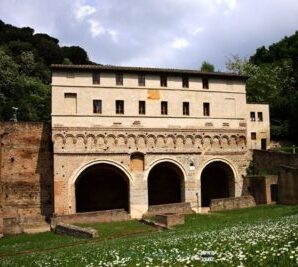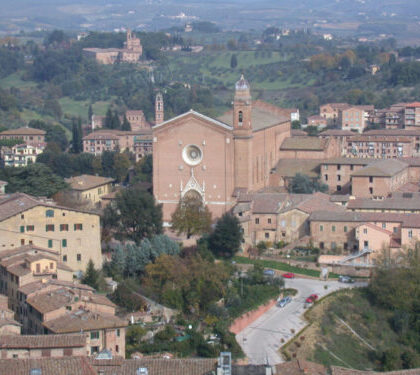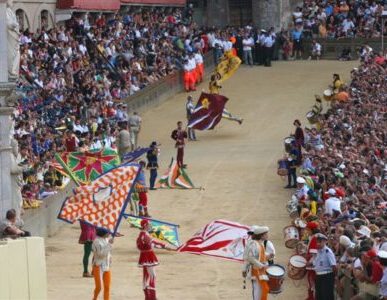Adolescence
Self-determination was not something that the Emperors of the time could give away so easily. The formation of the Lombard League aimed on the protection of that autonomy against the Emperor’s wishes and although Siena had more or less the same goal, in the war between the two alliances it sided with the Emperor against the interests of the Papal States & of course Florence.
The decision proved to be wise although the army of Frederick Barbarossa lost at the Battle of Legnano in 1176 and the Emperor was forced to concede the right to freely elect town magistrates in 1183 to the cities of the Lombard League. Sienna’s alliance had secured the same right 3 years earlier, together with the right to mint its own coin and other territorial concessions, which gave vent to the city’s growth & prosperity.


The next emperor, Henry VI (r.1190 to 1197) was not so keen on keeping the concessions made to his Italian subjects by his father, nor on accepting the Pope’s geopolitical role. That led Siena to an uneasy and short-lived alliance with Pope Celestine III, Florence and the rest of the Tuscan cities known as the League of San Genesio in 1197.
Despite the internal discords the importance of the Tuscan League was enormous since it was the first time that the participant Tuscan cities united against a common enemy in order to prevent the restoration of German sovereignty. In the same time it set the foundations of the Peace of Fonterutoli that was signed on March 29, 1201 between Florence and Siena, which ended a costly ten year conflict and secured the safe passage of the merchants of both city-states in the whole Tuscan region, commencing a new era of economic relations and increased trade transactions.



It was very clear however that the rift between the two sides, the ones that had fought on the side of the Pope when the civil conflicts had started and were known as the Guelphs (Side of the Republic of Florence) and the ones who stood by the Emperor known as the Ghibellines (Side of the Republic of Siena) could not be easily bridged.


During the first half of the 13th century the civil conflicts between different cities and even within cities between the church party and the imperial party were constant. Sienna’s internal feuds were somewhat pacified through the practice of the free election of the city’s consuls who in a short period of time managed to accomplish three very important feats.
They managed to decrease the influence of the various feudal lords, to ensure the application of reasonable duties and taxes within the limits of the republic and face the chronic shortage of manpower by accepting all new residents as equal citizens of the Sienese Republic.


The lack of raw materials prevented the creation of a powerful manufacturing industry but in the same time it steered the Sienese economy towards banking, finance and commerce where it very soon gained a competitive advantage compared to its neighbors. In the first decades of the 13th century the first corporations were formed while Sienese merchants could be found in every major market between Northern Europe and the Mediterranean basin, acting as intermediaries of all sorts of raw and processed materials.
The generated capital created wealth which transformed a traditional agricultural society to a vibrant economic hub of the time. New magnificent houses like the Palazzo Tolomei are erected by the ones who reap the benefits of the economic upturn and monumental new works like the construction of a new Duomo, of new water fountains like Fonte di Pescaia & Fonte Nuova, of new Basilicas like the Basilica of San Domenico & the Basilica di San Francesco are financed by both the government and private funds. The first university, a School of Humanities and Philosophy, the Studium Senese is founded in 1240 funded by the taxes of the student rents.



The powerful merchant families like the Salimbeni were quickly incorporated in the city’s institutions creating the new ruling class which was bound by the regulations of the written constitution and the values of the Republic. Safe-keepers of those values were of course the people, usually representatives of various guilds, arts and military companies who filled half of the seats of the council. Finally there was the “Captain of the People” also known as the Podesta, a commander of a limited time who led the army and directed the City council.



Early 13th century was also the period when an old Etruscan tradition of bareback horse-racing known as “Palio di San Bonifacio “ (San Bonifacio was the name of the first cathedral of the city on the site of the Duomo) was revamped in opulence, took a more formal form and was dedicated to Santa Maria Assunta (the Assumption of Mary), the new patron Saint of the Sienese State.



In 1250, the merchants and the artisans of Florence managed to usurp the power of the Ghibelline nobles and initiate a new policy. Soon the radical faction of the Florentine Guelphs who wanted to completely eradicate the influence of the Ghibelline in the city and the region of Tuscany known as the Black Guelphs took the helm of the Florentine state.



In the spring of 1260, the Sienese were laying a siege on the nearby fortress-town of Montalcino for a third time in only few years, in order to secure the control of Via Francigena that led to Rome. The Florentines decided to go to the offensive and aid the besieged in order to cripple the hated Ghibellines.
All males of Florence between 15 and 70 years old were summoned to arms and were soon joined by the troops of Genoa, Piacenza, Bologna, Lucca, Pistoia, Prato, Arezzo, Volterra, San Gimignano and the papal towns of Perugia and Orvieto. There were even some Sienese –exiled Guelphs who wanted to take power in their home town that joined in, rising the number of the Guelph army to 35.000 soldiers in total.


On the other side the Sienese could only depend on the support of Pisa (traditional enemy of Florence & Genoa), Cortona and the exiled Florentine Ghibellines who had found refuge in Siena. In the summer of 1260, with the Florentine army having already crossed the region of Chianti, the Sienese council convened in the cloister of San Cristoforo where they would receive the Florentine delegates.
The Florentine terms however left no space for further discussion and could not be accepted without humiliation. Acknowledging the handicap of their camp against the massive Florentine army, the council expressed the need of hiring more troops from King Manfred of Sicily who ruled over southern Italy and was considered a Ghibelline but there was a serious problem with that choice. The Sienese lacked the needed funds. The wealth of the Salimbeni family would provide the solution and in a very short period of time the Sienese army included 20.000 strong.



On September 4, 1260, the Florentine army was preparing to set camp on the plain of Montaperti, a hill within sight of Siena, when the German knights of King Manfred launched their surprise attack. What followed is considered the bloodiest day in the Italian Middle Ages and is described by Dante, in the Divine Comedy as “The havoc and the great slaughter, which dyed the Arbia (small Tuscan River) red”.





Although outnumbered the Sienese managed to crush their hated enemies, in a victory so resounding that still echoes today whenever the two cities meet in various sporting events. More than 10.000 dead, 4.000 missing and 15.000 captured were the staggering numbers on the side of the Guelphs in contrast to the 600 Ghibellines who lost their lives.
The “miracle of Montaperti” immediately ended the Guelph rule in Florence and forced most of the neighboring towns to accept Sienna’s hegemony in the region. It was a glorious time for the city that would be celebrated with the completion of the first phase of the Duomo in 1264.




